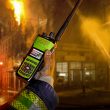School of Hard Knocks
Every Four Years, there are events — the Olympics, presidential elections and soccer’s World Cup — that become the focus of media attention for their duration — and their aftermath — and cause observers to reflect upon historical references as a means of determining whether progress has been made since the last time the transcendent event occurred.
The remarkable pageantry and eager anticipation surrounding such scheduled happenings contrast starkly with the tragedy and dread associated with the recent Southern California wildfires that destroyed more than 500,000 acres, causing several hundred millions of dollars in damage and 10 deaths. However, like the aforementioned quadrennial events, the 2007 siege has allowed state and local officials to assess their agencies’ progress in responding to such disasters after a remarkably similar set of fires ravaged the area in 2003.
“There were more fires this time — seven main fires instead of four main fires — and they went over a six-day period of time instead of a five-day period of time,” said Chris Hinshaw, manager of the wireless communications division for the San Diego County Sheriff’s Department, which oversees the San Diego-Imperial County Regional Communications System (RCS). “Approximately the same amount of acreage was lost, but there weren’t nearly as many fatalities or injuries.”
One key reason for the reduction in human suffering during the 2007 fires was better communication among the responding agencies and with the public — a noticeable difference compared to 2003, when issues regarding operability, interoperability and public information plagued the response effort.
In fact, several improvements in the ensuing four years — some made as a direct response to the 2003 fires — proved to have a positive impact on communications during the 2007 siege.
“Obviously, things didn’t go perfect, because I don’t think anything can go perfect in these type of events, but I’m thoroughly impressed,” said Chet Ashbaugh, Riverside County’s fire communications manager. “From what I’ve seen over the previous years, a lot of [the difference] is the dissemination of information and that some of these groups are meeting and working well together.”
IMPROVED INTEROPERABILITY
Indeed, there were significant problems in 2003 regarding various agencies’ ability to communicate and coordinate their response efforts. Much of the difficulty stemmed from the fact that federal and state forestry services operate on conventional VHF systems, while most of the San Diego-area first responders operate on 800 MHz trunked systems.
“Some of those issues have been taken care of by obtaining each other’s permission to use each other’s frequencies and then gaining the radios to use those frequencies,” said Dave Sinclear, forest fire chief at Mendocino National Forest.
Sinclear also said he did not hear complaints about frequency coordination, which was a “major issue” in 2003. Ashbaugh agreed, noting that the only frequency-coordination problems he heard about were minor in nature.
Hinshaw said the cooperative efforts of groups such as the Law Enforcement Assistance Network and the San Diego Fire Chiefs Communications Committee have made a big difference in the level of communications interoperability in the area. Both groups existed in 2003 but were in their infancy. Today, after five years of regular meetings, the impact of such groups has yielded tangible improvements in interoperability for both day-to-day and large-incident responses, Hinshaw said.
“Everybody’s a lot more comfortable working together than we were in the past — there’s been a level of trust built up between the agencies,” he said. “The technology itself hasn’t really changed, although the availability of the technology — through increases in capacity — has changed. But the users’ knowledge of, use of and comfort level with interoperability has increased markedly.”
Ashbaugh echoed this sentiment, noting that the communications cooperation among Southern California response entities has reached unprecedented levels.
“Never before have I ever seen, in the past 15 years, the communications committee — propeller-heads like myself, management and the operations — come together and work as well together from a communications perspective,” he said. “It seems like now there is a dissemination of information and getting people on the same page, and knowing who to go to with communications problems is helping out a lot.”
OPERABILITY: GOT TO HAVE IT
Of course, interoperable communications are possible only when the networks being used are operating and have enough available capacity to handle all requests. That was a problem for the RCS in 2003, when many complaints were voiced about the 800 MHz system generating too many busy signals during key points in the response effort.
Since then, the RCS has received a $21 million enhancement that increased capacity in the western zone by 20% and increased capacity in the eastern zone by 80%, Hinshaw said. During the 2007 fire siege, the RCS exhibited a 71% performance improvement compared to 2003 based on the percentage of busy signals on the network , thanks largely to capacity improvements and better use of available resources. (See “Déjà Vu” on page 44.)
“We were able to manipulate the system better this time,” Hinshaw said. “We were able to see where we were having issues and able to control management of the radio system remotely, which enabled us to resolve some bottlenecks and those kinds of things.”
And the 800 MHz system’s capacity was available at all times, despite the fires engulfing some tower sites, Hinshaw said. Practicing good fundamentals such as clearing brush from the sites and pretreating a couple of sites with flame-retardant chemicals helped keep each of the towers on the air and limited the total damages at the sites to about $17,000, he said.
“It was combination of good fortune and design,” Hinshaw said. “The sites are hardened, so there’s not a lot to burn in a radio site — they’re built of concrete or built with structural, non-burnable materials.”
As is often the case in disasters, the biggest challenge in maintaining communications was power, because fire damage disabled the commercial power grid in many areas. Hinshaw said. At one point in the response effort, 19 of the 67 RCS sites depended solely on power from generators that required regular refueling, he said.
Fires also disabled more than 250 miles of telephone cabling, but that did not disrupt the RCS system, which uses looped microwave links instead of T1s to handle backhaul traffic from the tower sites, Hinshaw said.
“Copper is evil,” he said.
THE PUBLIC’S RIGHT TO KNOW
One of the most significant endeavors of the 2007 wildfire response effort was the evacuation of more than 500,000 residents to safe havens such as Qualcomm Stadium in San Diego. In 2003, police and fire personnel did this manually, knocking on residents’ doors to give them directions about the best way to proceed to safety.
Not only was the door-knocking method time consuming, it proved to be flawed in other ways. Certain area residents were visited by representatives from different entities and given contradictory directions whether to evacuate or stay in the house — in some cases with fatal results, according to some after-action reports.
As a result, the San Diego Sheriff’s Department, the city of San Diego and San Diego County installed automated emergency-alert communications systems, said Gail Larsen, communications coordinator for the San Diego County Sheriff’s Department.
“We did not have anything like this during the fires of 2003,” she said. “It was a result of the after-action reports and analysis of how the fires went four years ago that made it clear that we needed to get this type of mass emergency-notification system working. Over the past four years, we’ve been working on that. Fortunately, it was in place and ready to go for the fires this year.”
Indeed, the automated emergency-alert systems largely were credited with making the large-scale evacuations possible. Not only did the automated alert systems notify residents much more quickly than the door-to-door approach, they allowed personnel who otherwise would have been knocking on doors to help coordinate evacuation traffic, secure evacuated areas or assist in the fire-response effort, Larsen said.
Although the three automated emergency-alert systems are separate, the division of labor between the systems is clear enough that it’s “not likely” that any residents received duplicate calls providing emergency information, Larsen said.
However, while the automated emergency-alert systems “worked really well,” Larsen said two main complaints were voiced. Some residents located just outside of notification territories expressed concern that their neighbors were ordered to evacuate and they were not. While such instances are unavoidable, the fact that the emergency-alert systems call landline telephone numbers is something that may need to be addressed in the future, she said.
“The other complaint we received … is from people who said, ‘I don’t have a landline phone. I use my cell phone, and I didn’t get a call,’” Larsen said.
Currently, the city and county systems let residents register their mobile-phone numbers with the alert systems, but this option is not available on the sheriff’s department’s system, Larsen said. Hinshaw said he believes the sheriff’s department will consider enabling cell-phone alerts in the future.
LOOKING AHEAD
Although wildfires are a part of life in California, officials are hopeful that the large-scale sieges experienced in 2003 and 2007 do not become a regular occurrence. However, first-responder communication representatives seemed encouraged that systems are better prepared than ever before to handle such difficult circumstances, and they should be even better in the future.
Hinshaw pointed to interoperability-focused training exercises as helping big-picture communications between entities. Meanwhile, the RCS expects to benefit greatly from the training of individual users on the best and most efficient ways to use precious radio resources. As of October, when the latest wildfires occurred, only about 300 of the 20,000 users on the system had completed the classes that are being conducted as part of the $250,000 program, but Hinshaw believes they will have considerable impact in the future.
“I can provide the best system that money can buy, but unless the users know how to use it, are comfortable using it and choose to use it, it doesn’t do much good,” he said. “Everybody’s comfortable with it, everybody’s using it and there’s a growing wave of people who know how to use it properly, so things are getting better.”
Ashbaugh said he also believes response communications in the state are moving in the right direction and that long-term efforts based on lessons learned during previous wildfires are beginning to yield tangible results.
“It’s like the Titanic; you can’t turn it on a dime,” he said. “As large as California is and as much as we’re exposed to disasters, it takes a long time to get everyone on the same page. I think we’re getting there.”
| 2007 Fires (Oct. 21-26) | 2003 Fires (Oct. 26-31) | |
|---|---|---|
| Requests for channel assignment (calls) | 1,226,678 | 1,104,287 |
| Busiest day | 264,048 calls on Oct. 22 | 265,355 calls on Oct. 26 |
| Delayed channel assignments (busies) | 33,021 | 104,605 |
| Average busy duration | 5.6 seconds | 19.1 seconds |
| The San Diego County?Imperial County regional communications system showed dramatic improvement in the amount and duration of “busies” from 2003 to 2007. | ||

















